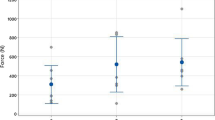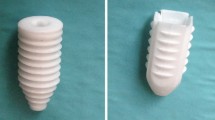Abstract
A failure analysis of interference screw fixation was performed to test the hypothesis that bovine and/or elderly human cadavers are appropriate models for bonepatellar tendon-bone anterior cruciate ligament (ACL) reconstruction fixation studies. Failure mode is an important criterion for validating experimental models. The bovine, young human, and elderly human failure loads were 799±261 N, 655±186 N, and 382±118 N, respectively, and the failure modes were 75%, 69%, and 30% tissue failures, respectively. The similarities between the bovine and young human models in failure loads and failure modes indicate that bovine models are appropriate for ACL reconstruction fixation studies. The statistically significant differences between the young human and elderly human models in failure loads and failure modes indicate that elderly human cadavers are not an appropriate model for ACL reconstruction fixation studies. The differences in failure modes are consistent with previous studies using elderly human cadavers in which the predominant failure mode was bone block pullout. The tissue failures observed in the bovine and young human models contradict previous studies suggesting fixation strength is the weakest link in bone-patellar tendon-bone ACL reconstruction. Results of linear regression modeling showed statistically significant correlations between insertion torque and failure load (R 2=0.44,P<0.0001) and interference (defined as the screw outer thread diameter minus the tunnel-bone block gap) and insertion torque (R 2=0.18,P=0.003) when data from all models was combined. Results for the bovine model multiple regression showed a statistically significant regression of insertion torque (linear) and interference (quadritic) versus failure load (R 2=0.56,P=0.02). Regression slopes for screw diameter (P=0.52) and gap size (P=1.00) were not statistically significant. These results indicate that insertion torque and interference are independent predictors of failure load and should be included in future interference screw studies in addition to bone block dimensions, tunnel size, gap size, and screw diameter. Clinicians may consider using insertion torque and interference as indicators of postoperative graft fixation regarding rehabilitation decisions.
Similar content being viewed by others
References
Brown CH, Hecker AT, Hipp JA, Myers ER, Hayes WC (1993) The biomechanics of interference screw fixation of patellar tendon anterior cruciate ligament grafts. Am J Sports Med 21:880–886
Burkes R, Daniel D, Losse G (1984) The effect of continuous passive motion on anterior cruciate ligament reconstruction stability. Am J Sports Med 12:323–327
Butler DL (1987) Evaluation of fixation methods in cruciate ligament replacement. In: Griffin PP (ed) Instructional course lectures, vol 36. American Academy of Orthopaedic Surgeons, Rosemont, pp. 173–178
Cassim A, Lobenhoffer P, Gerich T, Tscherne H (1993) The fixation strength of the interference screw in anterior cruciate ligament replacement as a function of technique and experimental setup. In: Transactions of the Thirty-Ninth Annual Meeting of the Orthopaedic Research Society, San Francisco, California, USA, p 31
Cody RP, Smith JK (1991) Applied statistics and the SAS programming language, 3rd edn. Prentice Hall, Englewood Cliffs
Glasgow SG, Gabriel JP, Sapega AA, Glasgow MT, Torg JS (1993) The effect of early versus late return to vigorous activities on the outcome of anterior cruciate ligament reconstruction. Am J Sports Med 21:243–248
Good L, Tarlow SD, Odensten M, Gillquist J (1990) Load tolerance, security, and failure modes of fixation devices for synthetic knee ligaments. Clin Orthop 253:190–196
Gordan GS, Genant HK (1985) The aging skeleton. Clin Geriatr Med 1:95–118
Hulstyn M, Fadale PD, Abate J, Walsh WR (1993) Biomechanical evaluation of interference screw fixation in a bovine patellar bone-tendon-bone autograft complex for anterior cruciate ligament reconstruction. Arthroscopy 9:417–424
Jomha NM, Raso VJ, Leung P (1993) Effect of varying angles on the pullout strength of interference screw fixation. Arthroscopy 9:580–583
Kohn D, Rose C (1994) Primary stability of interference screw fixation: Influence of screw diameter and insertion torque. Am J Sports Med 22:334–338
Kurosaka M, Yoshiya S, Andrish JT (1987) A biomechanical comparison of different surgical techniques of graft fixation in anterior cruciate ligament reconstruction. Am J Sports Med 15: 225–229
Lambert KL (1983) Vascularized patellar tendon graft with rigid internal fixation for anterior cruciate ligament insufficiency. Clin Orthop 172:85–89
Mathews LS, Lawrence SJ, Yahiro MA, Sinclair MR (1993) Fixation strengths of patellar tendon-bone grafts. Arthroscopy 9:76–81
Noyes FR, Grood ES (1976) The strength of the anterior cruciate ligament in humans and rhesus monkeys J Bone Joint Surg [Am] 58:1074–1082
Reznik AM, Davis JL, Daniel DM (1990) Optimizing interference fixation for cruciate ligament reconstruction. In: Transactions of the Thirty-Sixth Annual Meeting of the Orthopaedic Research Societ: New Orleans, Louisiana, USA p 519
Rosner B (1990) Fundamentals of biostatistics, erd edn. PWS-Kent
Shapiro JD, Cohn BT, Jackson DW, Postak PD, Parker RD, Greenwald AS (1992) The biomechanical effects of geometric configuration of bone-tendon-bone autografts in anterior cruciate ligament reconstruction. Arthroscopy 8:453–458
Shelbourne KD, Nitz P (1990) Accelerated rehabilitation after anterior cruciate ligament reconstruction. Am J Sports Med 18:292–299
Author information
Authors and Affiliations
Rights and permissions
About this article
Cite this article
Brown, G.A., Peña, F., Grøntvedt, T. et al. Fixation strength of interference screw fixation in bovine, young human, and elderly human cadaver knees: Influence of insertion torque, tunnel-bone block gap, and interference. Knee Surg, Sports traumatol, Arthroscopy 3, 238–244 (1996). https://doi.org/10.1007/BF01466626
Received:
Accepted:
Published:
Issue Date:
DOI: https://doi.org/10.1007/BF01466626




